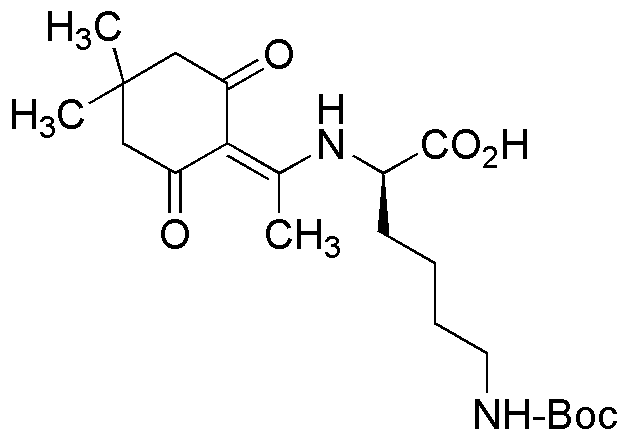Na-1-(4,4-Dimethyl-2,6-dioxocyclohex-1-ylidene)ethyl-Ne-Boc-D-lysine is widely utilized in research focused on:
- Peptide Synthesis: This compound serves as a key building block in the synthesis of peptides, particularly in the development of therapeutic proteins and biologics.
- Drug Development: It plays a crucial role in the design of new drug candidates, especially in the field of oncology, where modifications to amino acids can enhance drug efficacy.
- Bioconjugation: This chemical is used in bioconjugation processes, allowing researchers to attach drugs or imaging agents to biomolecules, which is essential for targeted therapies.
- Research in Chemical Biology: It aids in the study of protein interactions and functions, providing insights that can lead to breakthroughs in understanding disease mechanisms.
- Development of Novel Therapeutics: The unique structural features of this compound facilitate the creation of innovative therapeutic agents that can overcome resistance in existing treatments.
General Information
Properties
Safety and Regulations
Applications
Na-1-(4,4-Dimethyl-2,6-dioxocyclohex-1-ylidene)ethyl-Ne-Boc-D-lysine is widely utilized in research focused on:
- Peptide Synthesis: This compound serves as a key building block in the synthesis of peptides, particularly in the development of therapeutic proteins and biologics.
- Drug Development: It plays a crucial role in the design of new drug candidates, especially in the field of oncology, where modifications to amino acids can enhance drug efficacy.
- Bioconjugation: This chemical is used in bioconjugation processes, allowing researchers to attach drugs or imaging agents to biomolecules, which is essential for targeted therapies.
- Research in Chemical Biology: It aids in the study of protein interactions and functions, providing insights that can lead to breakthroughs in understanding disease mechanisms.
- Development of Novel Therapeutics: The unique structural features of this compound facilitate the creation of innovative therapeutic agents that can overcome resistance in existing treatments.
Documents
Safety Data Sheets (SDS)
The SDS provides comprehensive safety information on handling, storage, and disposal of the product.
Product Specification (PS)
The PS provides a comprehensive breakdown of the product’s properties, including chemical composition, physical state, purity, and storage requirements. It also details acceptable quality ranges and the product's intended applications.
Certificates of Analysis (COA)
Search for Certificates of Analysis (COA) by entering the products Lot Number. Lot and Batch Numbers can be found on a product’s label following the words ‘Lot’ or ‘Batch’.
*Catalog Number
*Lot Number
Certificates Of Origin (COO)
This COO confirms the country where the product was manufactured, and also details the materials and components used in it and whether it is derived from natural, synthetic, or other specific sources. This certificate may be required for customs, trade, and regulatory compliance.
*Catalog Number
*Lot Number
Safety Data Sheets (SDS)
The SDS provides comprehensive safety information on handling, storage, and disposal of the product.
DownloadProduct Specification (PS)
The PS provides a comprehensive breakdown of the product’s properties, including chemical composition, physical state, purity, and storage requirements. It also details acceptable quality ranges and the product's intended applications.
DownloadCertificates of Analysis (COA)
Search for Certificates of Analysis (COA) by entering the products Lot Number. Lot and Batch Numbers can be found on a product’s label following the words ‘Lot’ or ‘Batch’.
*Catalog Number
*Lot Number
Certificates Of Origin (COO)
This COO confirms the country where the product was manufactured, and also details the materials and components used in it and whether it is derived from natural, synthetic, or other specific sources. This certificate may be required for customs, trade, and regulatory compliance.


